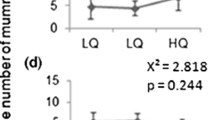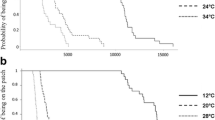Abstract
The time allocation of individualAphidius colemani female parasitoids foraging forAphis gossypii nymphs on cucumber leaves has been investigated. Apart from experiences on the current leaf (such as density of hosts on the current leaf, density of hosts on a neighboring leaf and encounters with hosts on the current leaf), the effect of previous leaf visits on the time allocation was studied. Behavioral records were analyzed by means of the proportional hazards model, to determine the tendency of leaving the current leaf. The leaving tendency decreased only on leaves with a high host density (100 aphids), thus increasing the giving up time since the latest encounter. Rejection of aphids had no influence on the leaving tendency. To assess the effect of the number of hosts encountered on the leaving tendency, we considered three classes: 0–30 encounters, 31–100 encounters, and 100 or more encounters with hosts. The effect of the number of hosts encountered differed at different aphid densities. When fewer than 10 aphids were present the leaving tendency was much greater after 30 encounters than beforehand. At a density of 100 aphids the leaving tendency was lower than at the other aphid densities and increased only after 100 encounters. The density of hosts on a neighboring leaf, ranging from 0 to 100 hosts, had a negligible effect on the leaving tendency. Repeated visits to leaves with 10 unparasitized aphids resulted in an increase in the leaving tendency after 10 visits. It is argued that the parasitoids have some innate expectancy of host availability and that they concentrate on high-density patches.
Similar content being viewed by others
References
Bennison, J. A., and Corless, S. P. (1993). Biological control of aphids on cucumbers: Further development of open rearing units or “banker plants” to aid establishment of aphid natural enemies.SROP/WPRS Bull. 16(2): 5–8.
Bouchard, Y., and Cloutier, C. (1985). Role of olfaction in host finding by aphid parasitoidAphidius nigripes (Hymenoptera: Aphidiidae).J. Chem. Ecol. 11: 801–808.
Budenberg, W. J. (1990). Honeydew as a contact kairomone for aphid parasitoids.Entomol. Exp. Appl. 55: 139–147.
Charnov, E. L. (1976). Optimal foraging, the marginal value theorem.Theor. Pop. Biol. 9: 129–136.
Chow, F. L., and Mackauer, M. (1986). Host discrimanation and larval competition in the aphid parasiteEphedrus californicus.Entomol. Exp. Appl. 41: 243–254.
Cox, D. R. (1972). Regression models and life tables.Biometrics 38: 67–77.
Driessen, G., Bernstein, C., Van Alphen, J. J. M., and Kacelnik, A. (1994). A count down mechanism for host searching in the parasitoidVenturia canescens.J. Anim. Ecol. 64: 117–125.
Gardner, S. M., Ward, S. A., and Dixon, A. F. G. (1984). Limitation of superparasitism byAphidius rhopalosiphi: A consequence of aphid defensive behaviour.Ecol. Entomol. 9: 149–155.
Haccous, P., and Hemerik, L. (1985). The influence of larval dispersal in the cinnabar moth (Tyria jacobaeae) on predation by the red wood ant (Formica polyctena): An analysis based on the proportional hazards model.J. Anim. Ecol. 54: 755–770.
Haccou, P., de Vlas, S. J., van Alphen, J. J. M., and Visser, M. E. (1991). Information processing by foragers: Effects of intra-patch experience on the leaving tendency ofLeptopilina heterotoma.J. Anim. Ecol. 60: 93–106.
H⇘gvar, E. B., and Hofsvang, T. (1991). Aphid parasitoids (Hymenoptera, Aphidiidae): Biology, host selection and use in biological control.Biocontrol News Inform. 12: 13–41.
Hemerik, L., Driessen, G., and Haccou, P. (1993). Effects of intra-patch experiences on patch time, search time and searching efficiency of the parasitoidLeptopilina clavipes (Hartig).J. Anim. Ecol. 62: 33–44.
Hofsvang, T. (1988). Mechanisms of host discrimination and intraspecific competition in the aphid parasitoidEphedrus cerasicola.Entomol. Exp. Appl. 48: 233–239.
Iwasa, Y., Higashi, M., and Yamamura, N. (1981). Prey distribution as a factor determining the choice of optimal foraging strategy.Am. Nat. 117: 710–723.
Kalbfleisch, J. D., and Prentice, R. L. (1980).The Statistical Analysis of Failure Time Data, Wiley and Sons, New York.
Powel, W., and Zhang, Z.-L. (1983). The reactions of two cereal aphid parasitoids,Aphidius uzbekistanicus andA. ervi, to host aphids and their food-plants.Physiol. Entomol. 8:439–443.
Rabbasse, J. M. (1980). Dynamique des populations d'aphides sur aubergine en serre. 1. Considerations generales sur la colonisation et le developpement des populations de quatre especes dans de sud de la France.SROP/WPRS Bull. III(3): 187–198.
Rabasse, J. M., and Wyatt, I. J. (1985). Biology of aphids and their parasites in greenhouses. In Hussey, N. W., and Scopes, N. E. A. (eds.),Biological Pest Control. The Glasshouse Experience, Blandford Press, Poole, pp. 66–73.
Starý, P. (1975).Aphidius colemani Viereck: Its taxonomy, distribution and host range (Hymenoptera: Aphidiidae).Acta Ent. Bohemoslov. 72: 156–163.
Stephens, D. W., and Krebs, J. R. (1986).Foraging Theory, Princeton University Press, Princeton, NJ.
Van Alphen, J. J. M., and Galis, F. (1983). Patch time allocation and parasitization efficiency ofAsobara tabida, a larval parasitoid ofDrosophila.J. Anim. Ecol. 52: 937–952.
van Lenteren, J. C. (1991). Encounters with parasitized hosts: To leave or not to leave a patch.Neth. J. Zool. 41: 144–157.
van Lenteren, J. C., and Bakker, K. (1978). Behavioural aspects of the functional responses of a parasite (Pseudeucoila bochei Weld) to its host (Drosophila melanogaster).Neth. J. Zool. 28: 213–233.
Van Roermund, H. J. W., Hemerik, L., and Van Lenteren, J. C. (1994). The influence of intrapatch experiences and temperature on the time allocation of the parasitoidEncarsia formosa foraging for whitefly on tomato leaflets.J. Insect Behav. 7: 483–501.
Van Schelt, J., Douma, J. B., and Ravensberg, W. J. (1990). Recent development in the control of aphids in sweet peppers and cucumber.SROP/WPRS Bull. XIII(5): 190–193.
Van Steenis, M. J., and El-Khawass, K. A. M. H. (1995). Behavior ofAphidius colemani searching forAphis gossypii: Functional response and reaction to previously searched aphid colonies.Biocontrol Sci. Technol. 5: 339–347.
Waage, J. K. (1979). Foraging for patchily distributed hosts by the parasitoidNemeritis canescens.J. Anim. Ecol. 48: 353–371.
Author information
Authors and Affiliations
Rights and permissions
About this article
Cite this article
van Steenis, M.J., El-Khawass, K.A.M.H., Hemerik, L. et al. Time allocation of the parasitoidAphidius colemani (Hymenoptera: Aphidiidae) foraging forAphis gossypii (Homoptera: Aphidae) on cucumber leaves. J Insect Behav 9, 283–295 (1996). https://doi.org/10.1007/BF02213871
Revised:
Issue Date:
DOI: https://doi.org/10.1007/BF02213871




